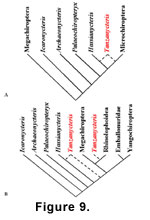PHYLOGENY
The phylogenetic affinities of Tanzanycteris remain unclear at this time. Many of the crucial character states important in bat phylogeny
(Simmons and Geisler
1998) are not preserved in the single known specimen of Tanzanycteris.
Table 2 presents a compilation (Simmons and Geisler
1998) of key microbat character states and their distribution among Icaronycteris, Archaeonycteris, Palaeochiropteryx, Hassianycteris, Tanzanycteris, and extant
microchiropterans. Of these 21 characteristics (some with multiple states) only seven can be accurately scored for Tanzanycteris.
 Based on the characteristics that can be scored for Tanzanycteris, several alternative phylogenetic hypotheses can be supported. If microchiropterans are monophyletic
(Figure 9A), then Tanzanycteris could either be a sister taxon to
Hassianycteris or to the extant microchiropteran
clade. If Microchiroptera is paraphyletic (Figure
9B), then Tanzanycteris could be the sister taxon of Hassianycteris, or of all extant bats (including
Megachiroptera), or of rhinolophoid microchiropterans. Further evidence is required before a more definitive statement can be made about the relationships of Tanzanycteris.
Based on the characteristics that can be scored for Tanzanycteris, several alternative phylogenetic hypotheses can be supported. If microchiropterans are monophyletic
(Figure 9A), then Tanzanycteris could either be a sister taxon to
Hassianycteris or to the extant microchiropteran
clade. If Microchiroptera is paraphyletic (Figure
9B), then Tanzanycteris could be the sister taxon of Hassianycteris, or of all extant bats (including
Megachiroptera), or of rhinolophoid microchiropterans. Further evidence is required before a more definitive statement can be made about the relationships of Tanzanycteris.
The discovery of Tanzanycteris is significant for bat paleobiogeography and evolutionary history, but the ramifications of the first mammal found in the Eocene of sub-Saharan Africa exceed the origin and diversification of
Chiroptera. The crater lakes of the Singida region, which have not yet been studied in detail, offer the first real opportunity to discover Eocene floral and faunal samples from the interior of Africa.

 Based on the characteristics that can be scored for Tanzanycteris, several alternative phylogenetic hypotheses can be supported. If microchiropterans are monophyletic
(Figure 9A), then Tanzanycteris could either be a sister taxon to
Hassianycteris or to the extant microchiropteran
clade. If Microchiroptera is paraphyletic (Figure
9B), then Tanzanycteris could be the sister taxon of Hassianycteris, or of all extant bats (including
Megachiroptera), or of rhinolophoid microchiropterans. Further evidence is required before a more definitive statement can be made about the relationships of Tanzanycteris.
Based on the characteristics that can be scored for Tanzanycteris, several alternative phylogenetic hypotheses can be supported. If microchiropterans are monophyletic
(Figure 9A), then Tanzanycteris could either be a sister taxon to
Hassianycteris or to the extant microchiropteran
clade. If Microchiroptera is paraphyletic (Figure
9B), then Tanzanycteris could be the sister taxon of Hassianycteris, or of all extant bats (including
Megachiroptera), or of rhinolophoid microchiropterans. Further evidence is required before a more definitive statement can be made about the relationships of Tanzanycteris.